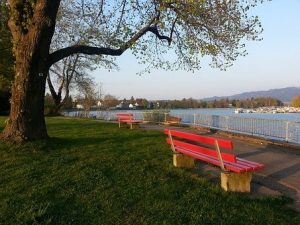Written by Taylor Woosley, Staff Writer. Results of this population-based cohort study show that participants living in closer relation to green spaces had a lower risk of ischemic stroke compared to individuals living with higher exposure to ambient air pollution.
 Across the globe, air pollution is considered the fourth highest risk factor associated with mortality 1. Both short- and long-term exposure to ambient air pollution have been linked to various health issues 2. In particular, exposure to particulate matter (PM) air pollution has been associated with higher occurrence of cardiovascular disease (CVD), such as ischemic heart disease and stroke 3. PM has been connected to systemic inflammation and atherosclerosis development which are major risk factors for ischemic heart disease and stroke 4.
Across the globe, air pollution is considered the fourth highest risk factor associated with mortality 1. Both short- and long-term exposure to ambient air pollution have been linked to various health issues 2. In particular, exposure to particulate matter (PM) air pollution has been associated with higher occurrence of cardiovascular disease (CVD), such as ischemic heart disease and stroke 3. PM has been connected to systemic inflammation and atherosclerosis development which are major risk factors for ischemic heart disease and stroke 4.
Stroke is currently the second leading cause of mortality globally and has an annual mortality rate of approximately 5.5 million people 5. Ischemic strokes account for more than 85% of stroke incidents 6. Ischemic strokes activate inflammatory and immune cells within the central nervous system which eventually leads to the obstruction of blood supply to brain tissue 7. The loss of blood to the brain induces irreversible damage to brain tissue and many stroke patients suffer chronic disabilities and cognitive impairment 8.
In this longitudinal prospective cohort study, Avellaneda-Gomez et. al observed the effects of long-term air pollution and green spaces and the incident of ischemic stroke (IS) on the adult population of Catalonia (n=3,521,274, aged ≥18 years). Pre-existing risk factors and other health data was obtained through the Catalan Central Registry of Insured Persons (between January 1, 2016 to December 31, 2017) which allows for data access across several health administration databases. Assessment of occurrence of green spaces was based on the Normalized Difference Vegetation Index (NDVI), which uses satellites to indicate high and low levels of greenness within a 300 m buffer. Subject’s individual exposure to ambient levels of air pollution: particulate matter (PM2.5), black carbon (BC), and nitrogen dioxide (NO2) were observed. The primary outcome measure was a first-ever incident of ischemic stroke diagnosis during the two-year follow-up period. After observing the study data, including the follow-up findings, the significant results are as follows:
- Individuals living in a residential area with higher exposure to air pollution were at a great risk of ischemic stroke incidence; HR for fixed 5 µg/m3 increments in PM5 1.04 (95% CI: 0.99-1.1); HR for fixed 10 µg/m3 increments in NO2 1.04 (95% CI: 1.03-1.06); and HR for 1 µg/m3 increments in BC 1.05 (95% CI: 1-1.1).
- An observed positive association between a higher average exposure to green spaces in a 300 m parameter around the residential area and IS was noted (HR 0.84; CI 95%: 0.7-1).
- NO2 was significantly associated with a higher risk of IS compared to exposure to BC and PM5.
Study results show the influence of air pollution on development or acceleration of cardiovascular disease and other chronic conditions. Further research should compare urban spaces across the globe to better understand how at-risk people living in highly populated residential spaces can be to certain health conditions based on ambient air pollution. Limitations include the short follow-up period of the study and lack of data of annual average exposure of participants several years prior to the follow-up period.
Source: Avellaneda-Gómez, Carla, Rosa M. Vivanco-Hidalgo, Sergio Olmos, Uxue Lazcano, Antònia Valentín, Carles Milà, Albert Ambròs, Jaume Roquer, and Cathryn Tonne. “Air pollution and surrounding greenness in relation to ischemic stroke: A population-based cohort study.” Environment International 161 (2022): 107147.
© 2022 The Authors. Published by Elsevier Ltd. This is an open access article under the CC BY license (http://creativecommons.org/licenses/by/4.0/)
Click here to read the full text study.
Posted April 25, 2022.
Taylor Woosley studied biology at Purdue University before becoming a 2016 graduate of Columbia College Chicago with a major in Writing. She currently resides in Glen Ellyn, IL.
References:
- Prabhu V, Singh P, Kulkarni P, Sreekanth V. Characteristics and health risk assessment of fine particulate matter and surface ozone: results from Bengaluru, India. Environ Monit Assess. Feb 23 2022;194(3):211. doi:10.1007/s10661-022-09852-6
- Xu R, Wang Q, Wei J, et al. Association of short-term exposure to ambient air pollution with mortality from ischemic and hemorrhagic stroke. Eur J Neurol. Apr 1 2022;doi:10.1111/ene.15343
- Koch S, Khomenko S, Cirach M, et al. Impacts of changes in environmental exposures and health behaviours due to the COVID-19 pandemic on cardiovascular and mental health: A comparison of Barcelona, Vienna, and Stockholm. Environmental pollution (Barking, Essex : 1987). Mar 29 2022:119124. doi:10.1016/j.envpol.2022.119124
- Kriit HK, Andersson EM, Carlsen HK, et al. Using Distributed Lag Non-Linear Models to Estimate Exposure Lag-Response Associations between Long-Term Air Pollution Exposure and Incidence of Cardiovascular Disease. Int J Environ Res Public Health. Feb 24 2022;19(5)doi:10.3390/ijerph19052630
- Ma Z, Chu L, Liu CF, Liu W, Wei J. Construction of a Joint Prediction Model for the Occurrence of Ischemic Stroke and Acute Myocardial Infarction Based on Bioinformatic Analysis. Dis Markers. 2022;2022:5967131. doi:10.1155/2022/5967131
- Mouhi S, Martin B, Owino S. Emerging Roles for the Orphan GPCRs, GPR37 and GPR37 L1, in Stroke Pathophysiology. Int J Mol Sci. Apr 5 2022;23(7)doi:10.3390/ijms23074028
- Zhang Y, Ren Y, Chen X, Deng S, Lu W. Role of Butylphthalide in Immunity and Inflammation: Butylphthalide May Be a Potential Therapy for Anti-Inflammation and Immunoregulation. Oxid Med Cell Longev. 2022;2022:7232457. doi:10.1155/2022/7232457
- Wang J, Zhang H, He J, Xiong X. The Role of the Gut Microbiota in the Development of Ischemic Stroke. Frontiers in immunology. 2022;13:845243. doi:10.3389/fimmu.2022.845243
